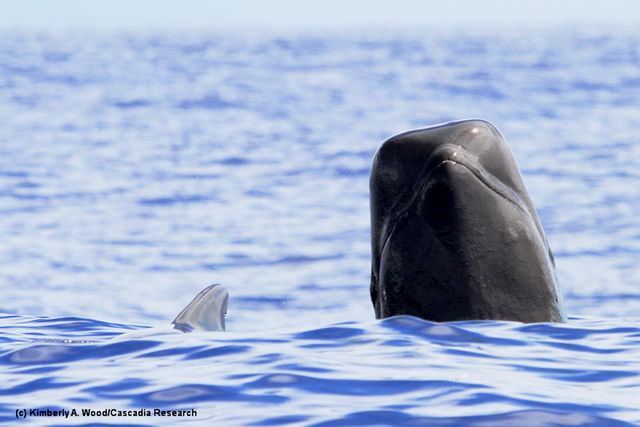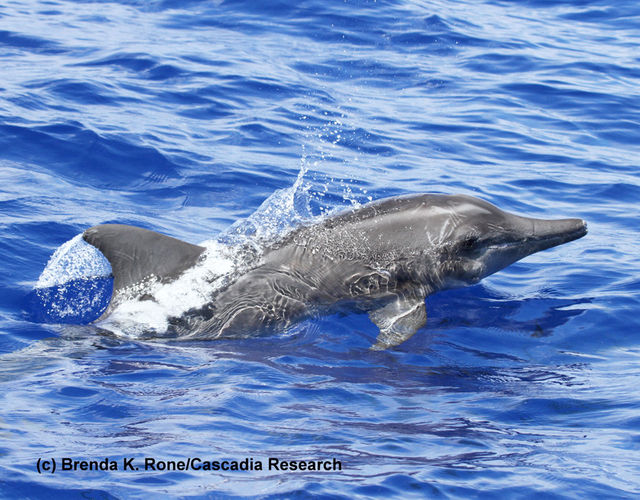LIHUE — A Navy-funded project landed five scientists on a research boat in the waters between Kauai and Niihau earlier this month in an effort to learn more about the effects of sonar on whales and dolphins. Researchers deployed five
LIHUE — A Navy-funded project landed five scientists on a research boat in the waters between Kauai and Niihau earlier this month in an effort to learn more about the effects of sonar on whales and dolphins.
Researchers deployed five depth-transmitting satellite tags via air rifle onto the dorsal fins of two pilot whales, a false killer whale, a rough-toothed dolphin and a bottlenose dolphin over the course of nine days. The goal of the tagging project is to help scientists — and the military — better understand what species react to Navy sonar exercises, what types of reactions occur and the duration and the magnitude of the response.
Cascadia Research Collective, an independent nonprofit, led the field project, which began Sept. 3. It is Cascadia’s 13th field project, and the second this year, aimed at understanding how sonar is influencing marine mammals in the waters off Kauai’s Westside, where the Navy operates a mid-frequency active sonar range.
The project was funded by the Navy through the Living Marine Resources program.
The noise produced by military sonar has the potential to harm or kill marine mammals who rely on sound to communicate and monitor their surroundings.
Some species are more sensitive to the noise than others. Not much is known about how different species react to one-time sonar exposure versus those who experience it repeatedly throughout their lifetimes.
Cascadia research biologist Robin Baird said the team is tracking location and movement data from four of the tagged animals. The tag deployed on the bottlenose dolphin has since fallen off, he said.
“What is probably happening, and this is somewhat of a conjecture, is these resident populations of pilot whales, rough-toothed dolphins, bottlenose dolphins … are being exposed to Navy sonar repeatedly throughout their lives,” Baird said. “So what I think that translates to is that when they hear Navy sonar they aren’t particularly startled by it.
“The corollary to that is the animals that are not resident to the island, who move through the area … they are probably rarely, if ever, exposed to Navy sonar. Those groups, I think, are more likely to show a startled reaction to Navy sonar.”
Marine mammals aren’t necessarily unharmed by sonar just because they don’t show a startled reaction to it, Baird said.
Other say sonar is absolutely harmful to marine life and took legal action against it.
Earlier this month the Navy agreed to limit its use of sonar off Hawaii and California. The deal bans sonar and explosives training on the eastern side of the Big Island and north of Molokai and Maui.
The settlement comes after Earthjustice and other environmental groups sued in 2013, challenging the fisheries service’s decision to allow the training, according to The Associated Press.
Additional environmental groups later filed a similar lawsuit in San Francisco. The two cases were consolidated in Hawaii, and the deal resolves both.
“If a whale or dolphin can’t hear, it can’t survive,” David Henkin, an attorney for Earthjustice, said in a previous press release.
Earthjustic said scientific studies have documented the connection between high-intensity mid-frequency sounds, including Navy sonar, and serious impacts to marine mammals ranging from strandings and deaths to cessation of feeding and habitat avoidance and abandonment.
“Nonetheless, until now the Navy has refused to set aside biologically important areas to minimize such harm to vulnerable marine mammal populations,” the release said.
“We challenged the Navy’s plan because it would have unnecessarily harmed whales, dolphins and endangered marine mammals, with the Navy itself estimating that more than 2,000 animals would be killed or permanently injured,” Henkin said. “By agreeing to this settlement, the Navy acknowledges that it doesn’t need to train in every square inch of the ocean and that it can take reasonable steps to reduce the deadly toll of its activities.”
Until it expires in late 2018, the agreement will protect habitat for the most vulnerable marine mammal populations, including endangered blue whales, for which waters off Southern California are a globally important feeding area; and numerous small, resident whale and dolphin populations off Hawaii.
“This settlement proves what we’ve been saying all along,” said Marsha Green, president of Ocean Mammal Institute, in the release. “The Navy can meet its training and testing needs and, at the same time, provide significant protections to whales and dolphins by limiting the use of sonar and explosives in vital habitat.”
U.S. District Court Judge Susan Oki Mollway ruled in March that the fisheries service violated environmental laws when it approved the Navy’s plans. The military branch, she said, also failed to take a hard look at alternatives such as training in different areas or at different times to avoid potentially harming dolphins, whales and other species.
In addition to tagging, Baird said the researchers captured 16,000 photos of the whales and dolphins they encountered to contribute to ongoing studies of residency patterns and social organization and to estimate population sizes. Data from about 175 Navy hydrophones was used to locate the animals based on acoustic tracking.
The researchers also took a biopsy sample from a false killer whale in order to study its genetics.
Lt. Cmdr. Matt Knight, a U.S. Pacific Fleet spokesman, said the Navy is a world leader in funding independent research in an effort to reduce its impacts on marine mammals. In the last five years the Navy has committed approximately $160 million to research about the relationship between marine mammals and underwater noise.
The Navy also maintains a scientifically robust marine mammal monitoring program specific to Hawaii and Southern California. This program has been ongoing since 2008. More than $2.5 million in Navy funded research was conducted in 2015 alone, according to Knight.
“The Navy cares about marine mammals — we share the seas with them daily,” Knight said.
Cascadia researchers started satellite tagging marine mammals in Hawaiian waters in 2006. They started tagging for the specific purpose of studying the impacts of Navy sonar on marine mammals during the 2008 Rim of the Pacific Exercise. RIMPAC, the world’s largest international maritime warfare exercise, is held biennially during June and July in Hawaiian waters, including off the coast of Kauai’s Pacific Missile Range Facility.
All told, Cascadia has collected tag data from about 250 animals representing a dozen species.
It is expensive work, Baird said. The depth-transmitting satellite tags alone cost $5,000 each.
The researchers plan to return to the waters between Kauai and Niihau for another field project in early 2016.



